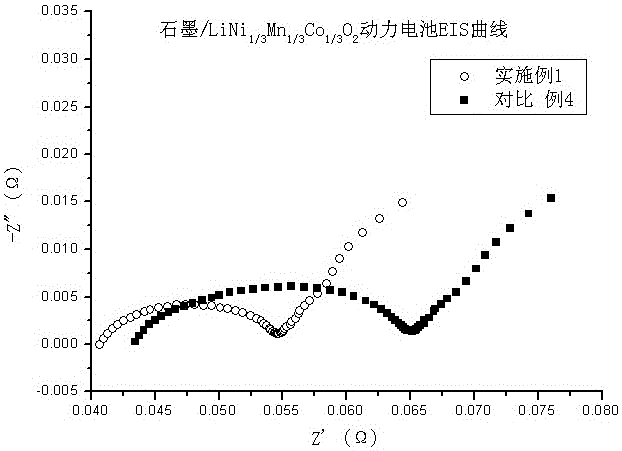Power lithium ion battery electrolyte and power lithium ion battery
A power battery and electrolyte technology, applied in the direction of secondary batteries, circuits, electrical components, etc., can solve the problem of affecting power output characteristics and low temperature output characteristics of power batteries, cannot meet the requirements of long cycle life of power batteries, and cannot form stable SEI protection Film and other problems, to achieve the effect of improving power characteristics and low temperature performance, improving charge and discharge efficiency, and improving output power characteristics
- Summary
- Abstract
- Description
- Claims
- Application Information
AI Technical Summary
Problems solved by technology
Method used
Image
Examples
Embodiment 1
[0026] Electrolyte preparation steps: In a glove box filled with argon, mix ethylene carbonate, diethyl carbonate and ethyl methyl carbonate according to the mass ratio of EC:DEC:EMC=3:2:5, and then add to the mixed solution Slowly add lithium hexafluorophosphate with a concentration of 1.0mol / L, and finally add 0.3wt% lithium difluorophosphate (LiPO 2 f 2 ), 2wt% lithium difluorosulfonyl imide (LiFSI), 1wt% vinyl sulfate (DTD), 0.5wt% vinylene carbonate (VC), and stir evenly to obtain the lithium-ion battery electrolyte of Example 1.
[0027] Inject the lithium-ion battery electrolyte prepared in the above steps into the fully dried 4.20V graphite / LiNi 1 / 3 co 1 / 3 mn 1 / 3 o 2 For power batteries (energy density>200Wh / kg), after the battery has been shelved at 45°C, formed in a high-temperature fixture and sealed twice, it is routinely divided.
[0028] 1) Cycling performance test at room temperature: At 25°C, charge the divided battery to 4.20V at 1C constant current and...
Embodiment 2~9
[0034] Embodiment 2~9 and comparative example 1~6
[0035]In Examples 2-9 and Comparative Examples 1-6, except that the composition and content of the electrolyte solvent and additives are added as shown in Table 1, the others are the same as in Example 1. Table 1 shows the contents of some components of the electrolyte and battery performance test results of Examples 1-9 and Comparative Examples 1-6:
[0036]
[0037]
[0038] Table 1
[0039] In the above Table 1, the abbreviated names of each chemical substance are as follows:
[0040] EC (ethylene carbonate), PC (propylene carbonate), DEC (diethyl carbonate), EMC (ethyl methyl carbonate), LiPO 2 f 2 (Lithium difluorophosphate), LiFSI (lithium bisfluorosulfonyl imide), LiDFOB (lithium difluorooxalate borate), DTD (ethylene sulfate), MMDS (methylene disulfonate), OT (ethylene disulfonate) Disulfonic anhydride, CAS: 4378-87-4), VC (vinylene carbonate), PS (1,3-propane sultone), LiBOB (lithium bisoxalate borate).
...
PUM
 Login to View More
Login to View More Abstract
Description
Claims
Application Information
 Login to View More
Login to View More - R&D
- Intellectual Property
- Life Sciences
- Materials
- Tech Scout
- Unparalleled Data Quality
- Higher Quality Content
- 60% Fewer Hallucinations
Browse by: Latest US Patents, China's latest patents, Technical Efficacy Thesaurus, Application Domain, Technology Topic, Popular Technical Reports.
© 2025 PatSnap. All rights reserved.Legal|Privacy policy|Modern Slavery Act Transparency Statement|Sitemap|About US| Contact US: help@patsnap.com



